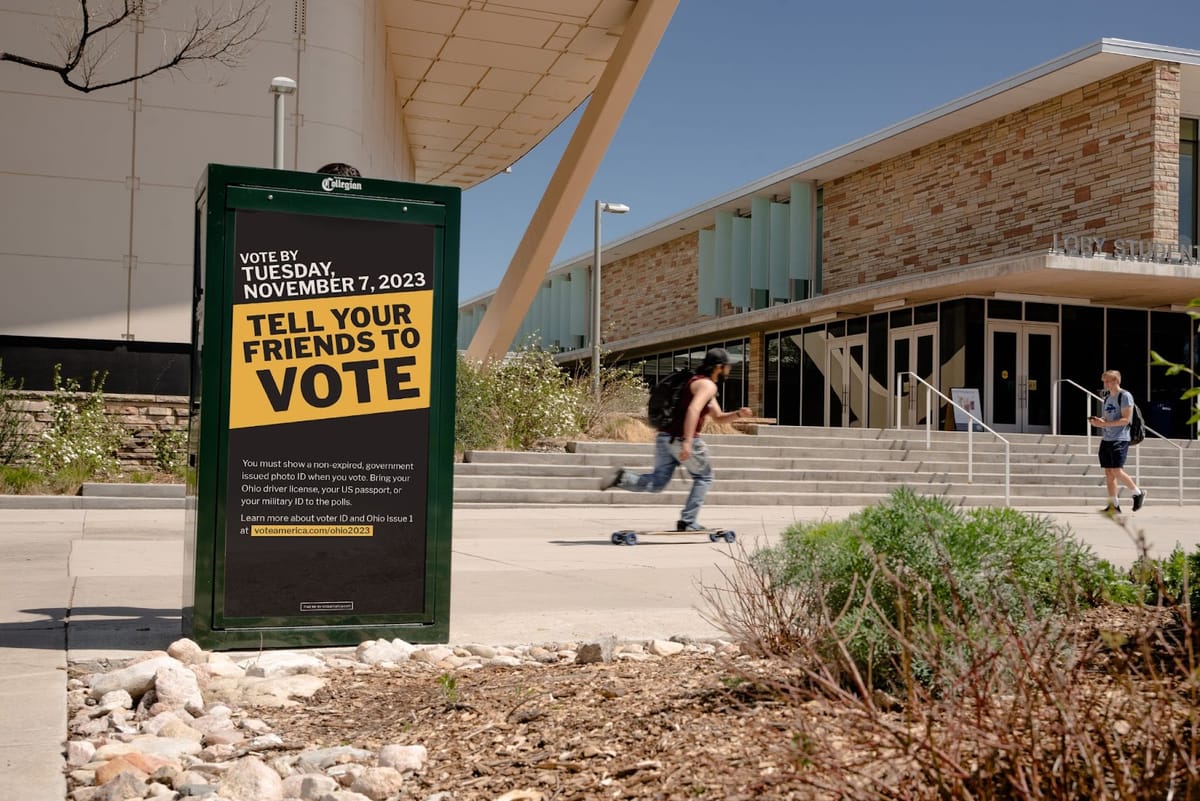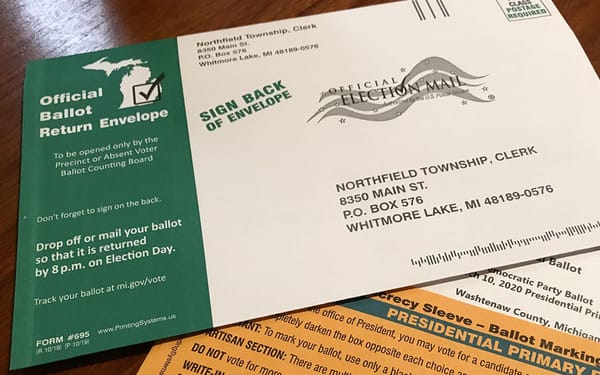VoteAmerica campus mobilization proposal for 2024

Overview
In 2024, VoteAmerica is ready to engage over 7 million college students on 559 campuses across the country with a 4-week, 6-channel mobilization program that is scalable, cost-effective, and potentially game-changing. We’ve been running this exact program for 7 years now, and have produced anywhere from a 2-8 point boost in turnout, depending on the amount of investment per student. This is an astonishing return on investment: according to recent meta-analysis by Professor Chris Mann and Professor Katherine Henschen, almost no other program produces more than 1 point boost in turnout.[1]
Background
The VoteAmerica team has been running campus mobilization programs since 2018. These programs rely on campus media, meaning advertising channels owned and operated by the schools. We run a multi-channel program that utilizes full-page ads on campus newspapers, digital takeovers of campus websites, on-campus transit ads, on-campus billboards, and on-campus “posters” which can be used to quickly cover a campus. Students read and trust their campus media. We lean into informational messaging: namely, telling students when to vote, where to go, what to bring, and who to contact if they need help. Our programs are C3 and nonpartisan. And they work.
- In 2018, we placed full color, full page ads on the back of 580 college newspapers. This was a single-channel, 1-week campaign. Turnout on these campuses was 2 percentage points higher than on our control campuses.[2]
- In 2019, we ran a multi-channel program on 33 campuses in Louisiana, Mississippi, and Kentucky over 12 weeks to evaluate the impact of multi-channel messaging campaigns on student behavior. We ran this program as a randomized control trial (RCT) in partnership with Chris Mann and saw an 8 percentage point increase in turnout on our target campuses.[3]
- In 2020, we brought this program to 243 campuses across 29 states, reaching over 2.8 million students. While the focus was on 7 states with key federal or statewide elections, we also targeted house districts with competitive elections and ran mobilization programs on 94 out of 107 HBCUs. This was the largest campus mobilization program of 2020. This program often ran instead of field programs: COVID rendered field almost nonexistent in 2020. In a survey conducted by Pantheon Analytics, we found a direct correlation between ad-spending (amount spent per student), ad-recall, voting knowledge, and election motivation.[4]
- In 2022, we brought our multi-channel program to 52 campuses across 9 states and reached over 1.3 million students. This program ran in three waves. The first wave was a 1 week voter registration campaign that ran on 8 campuses. The second wave focused on get-out-the-vote messaging, it ran for 2 weeks on 33 campuses and featured 3 campus media channels. The third and final wave ran during the final 5 days of the election on 25 campuses and featured 5 campus media channels. 2022 saw the second highest youth voter turnout in a midterm election in the last 3 decades.[5]
- In 2023, we ran this program in the April Wisconsin Supreme Court election. Although we stopped short of endorsing a candidate, we emphasized which candidate was pro-choice and which was anti-choice. This 1 week program ran on 24 campuses and reached over 233,000 students. Ultimately, the pro-choice candidate, Janet Protasiewicz, won a seat on Wisconsin's state Supreme Court with 55.5% of the vote. In many wards that are home to campuses, voter turnout surged and was close to the levels seen in the previous year’s midterm elections.[6] The Wisconsin Democratic Party identified this as an incredibly helpful part of the larger GOTV infrastructure.[7]
- As part of a coalition to protect abortion access, we also ran a program in Ohio’s 2023 Issue 1 election. This 4 week program ran on 12 campuses and reached over 272,000 students. As part of this program, we ran a post-campaign survey and found that 85% of students recalled seeing our election-advertising on campus. Turnout among students who recalled the advertising was significantly higher than those who didn’t (72% vs 64%).
Why invest in college students?
College-age voters can make a statistical difference in competitive races around the country.
- Of the 18.1 million people enrolled in college in 2023
- 15.2 million are enrolled in an undergraduate program
- 56% of students are female
- 49% of students are people of color.
- 7.6 million are under 24, and 2.2 million are under 30.
- 38% percent of 18-24 year olds were enrolled in college or graduate school in 2023. If you’re trying to reach this critical cohort of voters, campus is a good place to start.
- College students vote when issues they care about are on the ballot. 79% of students say they will vote in 2024 if it helps defend reproductive rights.
- Research shows that voting is habit forming: a young person who votes in 3 consecutive elections generally becomes a habitual and consistent voter (i.e. a lifetime voter).
- The most common reasons students give for not voting is that they missed the registration deadline, or that they were registered back home and couldn’t not get to the polls, or that they did not know when, where, and how to vote. These informational barriers are the ones VoteAmerica clears with our voter education campaigns.
Why on-campus media?
College students can be difficult to reach with traditional GOTV messaging for a number of reasons: they change addresses frequently, they don’t watch broadcast TV, and they block online ads.
- 63% of Gen Z blocks ads online.[8]
- 80% of 18-24 year olds always or often skip ads on Snapchat.[9]
- 47% of adults 22 to 45 years old are watching absolutely no content on broadcast TV.[10]
- But college students read and trust campus media. 70% of college students read their campus news sources on at least a weekly basis.[11] 47% of college students say their university newspaper or official campus communication platform is the primary way they learn about important events.
Why VoteAmerica’s program, specifically?
Over the years we’ve also learned a lot about why students on our targeted campuses didn’t vote.
- When students didn’t vote, it was because they faced an informational barrier that prevented them from casting ballots. These barriers included missing the voter registration deadline, not knowing how to register to vote, and not knowing where to vote or what to bring. These are the informational barriers that we clear with our program.
- Additionally, a significant percent of students miss elections because they are registered to vote with their home address, not their campus address, and were unable to get home to vote. A 1979 Supreme Court case established that students have dual residency, and can register to vote on campus. Again, this is an informational barrier that VoteAmerica can clear.
- VoteAmerica has extensive experience helping students decide where to register to vote. This year we’re relaunching a dormant program, called Countemore.us, that helps students decide between registering back home or on campus. Countmore tells them where their vote will count more, literally, thereby encouraging students to register and vote strategically
- VoteAmerica is well positioned to increase registration rates, and to increase turnout. We’ll use early money to ensure that students who attend college in competitive states register with their campus address. We’ll use late money to run targeted GOTV programs, with an extra emphasis on the states that offer same day registration.
Program costs & targeting
- We are recommending a 4-week, 6-channel program (called a “flight” in the advertising world) as a baseline program.
- We can and should scale this up: there is a lot of campus media that we can buy, and it is possible to fully-saturate a campus with informational messaging that will increase turnout (including the most essential: Election Day is November 5, 2024).
- With early funding, we could also split this into two flights: one focused on voter registration and one focused on turnout. Voter registration makes sense given how many of the students are out-of-state and are therefore more likely to be registered back home, if they are registered at all. This deck shows various examples of campus media and examples can be found at the end of this document.
Please contact finance@voteamerica.com if you’d like to invest in this program. Donations are tax deductible. There are many good campus programs. This is a great campus program. It works, it scales, and it’s cost-effective.
References:
- Mann, Haenschen, 2023
- Blue Labs, 2018
- Flytedesk, 2019
- Pantheon, 2020
- Inside Higher Ed, 2022
- The Washington Post, 2023
- They actually wanted to pay for the program, but their lawyers would not let them. So they made donor intros instead.
- Adweek, 2024
- DigiDay, 2018
- AdAge, 2017
- DigiDay, 2018
Appendix 1: Program costs by race
Appendix 2: Program costs by state
Appendix 3: Campus media types
Email Newsletters
Produced by college media organizations, this is content created by students sent to their entire campus community.
Digital Takeovers
Ads featured prominently on student-produced media properties. Some units can accommodate video in addition to static creative.
Newspapers
Premium placements in student newspapers. Ads are prominently displayed by the thousands across campus.
Posters and Flyers
Utilize boots on the ground to hang up posters, pass out flyers, and more.
Out of Home
Large format physical ads properties that are highly visible to campus foot-traffic. When we say “campus billboards” this is what we mean.
Campus Transit Ads
Large format panels which can be inside or outside of campus buses, or in the bus shelters. This is a type of out-of-home



